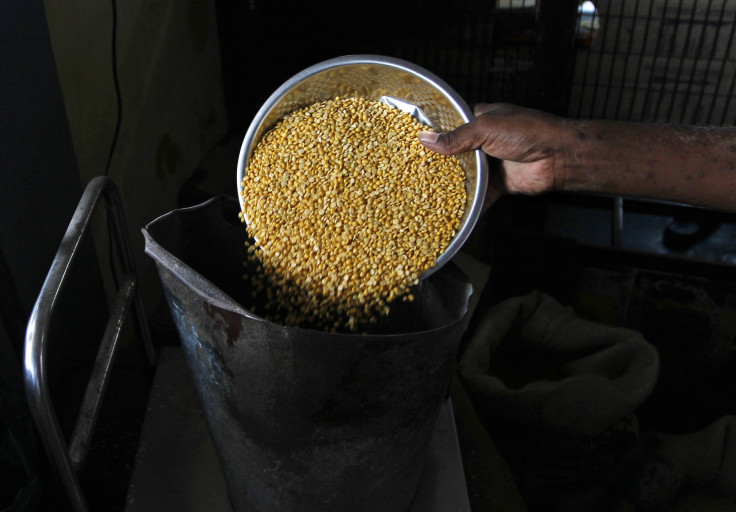India’s Ambitious $19.5 Billion National Food Security Bill Wins Lower House Approval

The lower house of the Indian parliament, on Monday, approved a food subsidy scheme to provide 5 kilograms (11 lbs) of rice, wheat, and coarse grains, at heavily subsidized rates, to two-thirds of the country’s population, or 800 million people, at an estimated cost of about $19.5 billion.
The flagship program of the ruling Congress Party-led coalition, the United Progressive Alliance, or UPA, overcame the Lok Sabha hurdle after a lengthy political gridlock, and amid widespread criticism that the bill could further fan India’s already high food inflation and lead to a food management crisis, even as the country struggles with its slowest growth rate in a decade.
India currently runs one of the world’s largest food subsidy programs, providing families below the poverty line with basic commodities at steeply discounted rates, while those above the poverty line get them at significantly less than market price.
The latest program, which is estimated to cost about 1.1 percent of the nation's gross domestic product, or GDP, aims to expand the reach of the existing system by covering 75 percent of rural households and half of urban households, and they will be uniformly entitled to receive 5 kilograms of food grains a month at prices as low as 3 rupees (about 5 cents) for a kilo of rice.
Under the new program, India’s food subsidy costs will shoot up almost 70 percent to reach 1.25 trillion rupees ($19.5 billion) for the year 2013-14, while the national budget allocates only 900 billion rupees for spending on food subsidies for the same period, apart from an additional 100 billion rupees set aside for the implementation of the bill. The figures mark a significant rise from the previous when the government spent 750 billion rupees on food subsidies.
The Lok Sabha passed the bill after it was amended to address state governments' concerns about the additional financial burden by enhancing federal government assistance in transportation and handling of the subsidized food grains. Lawmakers belonging to the main opposition, Bharatiya Janata Party, or BJP, who have criticized the measure as a vote-grabbing gimmick by the UPA ahead of next year's general elections, also voted in favor of the program.
The upper house of the Parliament, or Rajya Sabha, has to approve the bill before it can be signed into law by President Pranab Mukherjee. However, the implementation of the program is underway because the UPA issued an ordinance in July to begin the program before it could be approved by Parliament.
Inflation
The program has been severely criticized by many who claim that it will lead to the diversion of food grains away from the private sector and raise inflationary pressures on the open market.
India’s wholesale price index rose to a five-month high of 5.79 percent in July, on a yearly basis, and at its fastest pace since February. The rate, which is higher than the 5 percent target set by the Reserve Bank of India continues to pose difficulties for the central bank, which is under pressure to cut interest rates to boost economic recovery. In June, food inflation climbed for the second month in a row to 9.74 percent.
According to the Food and Agriculture Organization, India has seen one of the highest rates of food price inflation in Asia in recent years.
Food Management Crisis
Ashok Gulati, chairman of India’s Commission for Agricultural Costs and Prices, has warned that the adoption and implementation of the bill would lead to a serious food management crisis in the country, in the absence of correspondingly large-scale investments in irrigation, food-storage facilities and transport infrastructure to execute the program.
The scheme has led to misgivings that it will lead to increased pilfering of government food stocks for sale in the black market, and it could also lead to further wastage of government-procured produce due to poor storage facilities -- issues that have been dogging the country’s existing public distribution system, or PDS.
“Targeting the deserving population is a challenge, but that is a challenge government needs to undertake and with modern technology the government is better equipped than before in effective implementation,” Prof. S. Galab, director of Hyderabad-based Centre for Economic and Social Studies, told International Business Times in June. He added that Aadhaar, a new scheme of individual identification by the government, which uses a biometric system to avoid fake or duplicate identities, could eliminate public tampering of the PDS.
Battling Hunger
“India continues to battle persistent hunger and has failed to achieve some of the most important U.N. Millennium Development Goal targets like reduction in maternal and child mortality rates,” Galab said.
Despite being an emerging economy, poverty and malnutrition levels in eight Indian states are worse than in the 26 poorest African nations, according to a Multidimensional Poverty Index featured in a UNDP Human Development Report in 2010.
“Election year is around the corner and Congress Party is eyeing a program that appeals to millions in rural as well as urban areas,” Galab added, but dismissed arguments that the food security program would be short-lived if the ruling party lost the 2014 election.
He said the incoming government, regardless of who comes to power, “will definitely continue the program, because the language of poverty appeals to masses and no Indian political party can afford to abandon it.”
© Copyright IBTimes 2024. All rights reserved.












